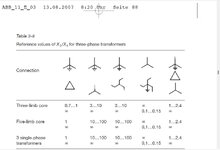I have seen this effect upstream of connected-neutral wye:delta banks.
Under non fault conditions, a wye:delta bank will backfeed an un-energized phase with full voltage.
The voltage drop under load will be increased above normal due to the added impedance of the wye:delta transformer.
To model the condition, think of three independant transformers in a bank and consider the unfaulted phases to act as an open delta.
Now consider the faulted phase transformer as a short circuited load across the third transformer.
The available fault current will be limited by the combined impedances of all three transformers.
The calculation of the peak offset current may be complicated as the point on wave will be different for each transformer and the currents in the unfaulted phases will be at 50% PF, one phase lagging and one phase lagging.
Many times I have sat in my room on the island while the small utility recovered fro an outage by switching in one phase at a time, manually.
WE had a couple of wye"delta banks on the system.
First phase goes in: Lights come on dim, about 50% voltage on each unpowered phase.
Second phase goes in: Brightness of lights increases. Not quite full brilliance due to the regulation of the wye:delta banks back-feeding the open phase.
Third phase goes in: The third phase is now fed directly and the lights go to full brightness.
Yes the wye:delta bank will back-feed upstream.
Back in the day of conversion from delta systems to wye:delta systems (40s to late 60s) it was a known effect that a shorted phase would result in fuses blowing through-out the distribution circuit.
Browse some old text books and you will find this mentioned.
The cause?
Overloaded wye:delta transformer banks through-out the circuit back feeding into a shorted phase.
Personally I would calculate the contribution to a single phase fault based on three individual transformers in a bank.
I would use three times the %imp of one transformer to calculate the ASCC for a back feed.
Or 1/3 of the ASCC of the three phase bank.
That should be safe for sizing protection devices as they are rated in ASCC Amps.
(More anecdotes on request. This effect will often cause customer damage. I have many times worked with customers to avoid this damage on systems that included wye;delta transformer banks.)

